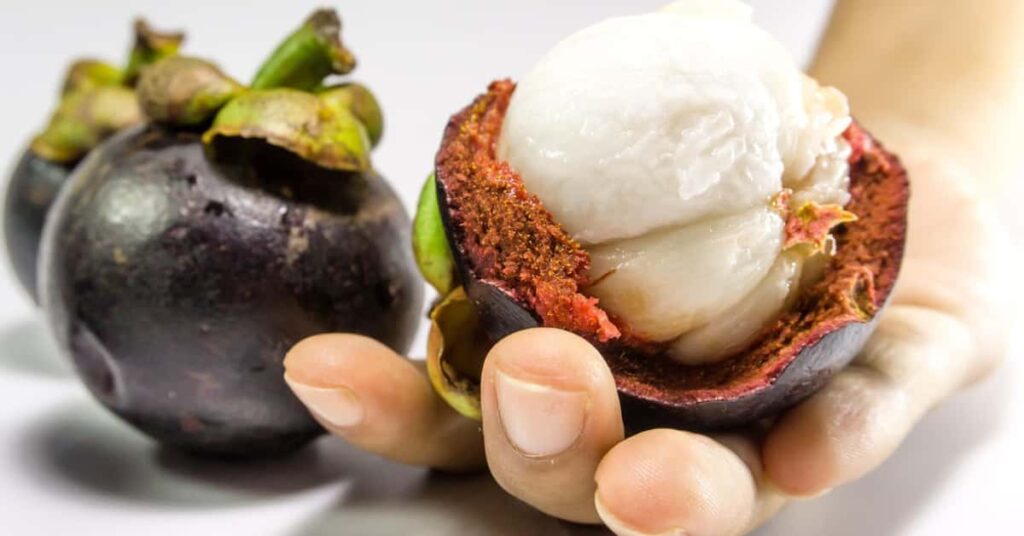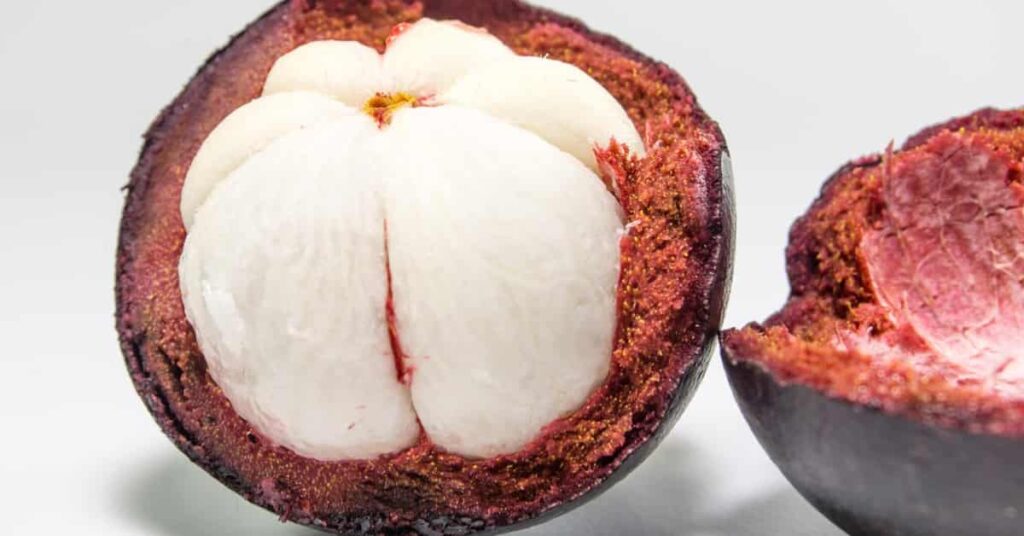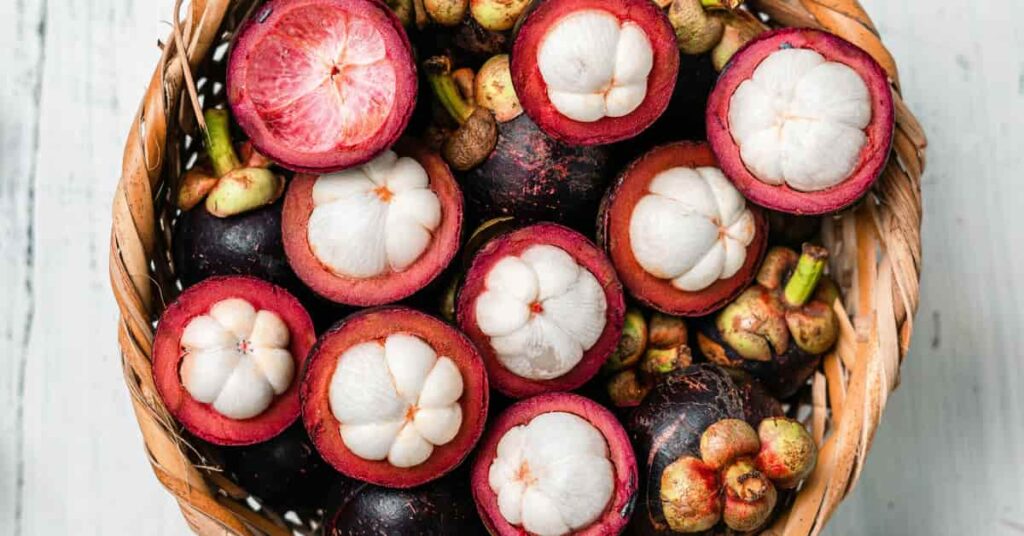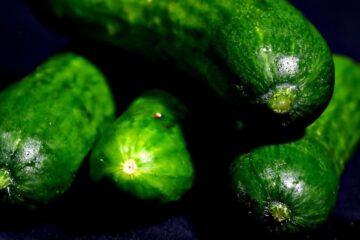Table of Contents
Introduction
Mangosteen (Garcinia mangostana) is a plant native to Southeast Asia. The fruit is a shade of purple or red. The fruit pulp is a little acidic and sweet. Mangosteen includes compounds that may act as antioxidants and support fighting infections.
People use Mangosteen for severe gum infections, muscle strength, obesity, diarrhea, and many other conditions, but there is little scientific evidence to support most of these uses.
Don’t confuse Mangosteen with Garcinia. These are not the same. But the fruit commonly known as Mangosteen is a species of the plant genus Garcinia. The scientific name for Mangosteen is Garcinia mangostana. The genus Garcinia contains many different species, and Mangosteen is just one of them.

Mangosteen
Mangosteen (Garcinia mangostana) is a highly revered tropical fruit, often nicknamed the “Queen of Fruits” for its exquisite flavor and powerful health benefits, and is primarily native to Southeast Asia. Characterized by a thick, dark purple rind (pericarp) and sweet, snow-white, segmented, and slightly acidic flesh, the Mangosteen offers a unique culinary experience. Beyond its luxurious taste, the fruit, particularly its rind, is an unparalleled source of unique and potent antioxidants called xanthones, which have driven extensive research into its significant anti-inflammatory, antimicrobial, and immune-boosting capabilities, establishing the Mangosteen as a key component in both traditional medicine & modern nutritional science.
Nutrition
A 200-gram approx. (one mug) serving of canned, drained mangosteen sealed in syrup offers:
- Calories: 143
- Carbs: 35 grams
- Fat: 1 gram
- Fiber: 3.5 grams
- Vitamin C: 6% of the daily value (DV)
- Protein: 1 gram
- Vitamin B9 (folate): 15% of the DV
- Vitamin B2 (riboflavin): 8% of the DV
- Vitamin B1 (thiamine): 9% of the DV
- Manganese: 9% of the DV
- Magnesium: 6% of the DV
- Copper: 15% of the DV

How to eat Mangosteen
Eating a mangosteen requires a little technique to cleanly separate the firm, bitter rind from the sweet, delicate flesh inside.
Here is a simple, step-by-step guide on how to open and eat a fresh mangosteen:
1. Preparation
- Select Ripe Fruit: Choose a mangosteen that feels firm but yields slightly to gentle pressure. The calyx (the green cap at the stem) should be green and fresh-looking. Avoid rock-hard fruits, as they are likely spoiled inside.
2. Opening the Rind (The Best Way)
The thick, purple rind (pericarp) is the part you need to remove.
- The Score Method (Recommended):
- Hold the fruit horizontally with the calyx (stem cap) facing your palm.
- Use a little paring knife to lightly score a shallow line all the way around the circumference of the fruit, cutting about halfway through the thick purple rind.
- Do not cut all the way through to the white flesh, as the rind is bitter.
- Carefully twist the two halves of the rind apart. The top half should lift off easily.
- The Squeeze Method (If Very Ripe):
- Hold the fruit horizontally.
- Place your thumbs on the score line (or on the natural soft line around the middle) and gently press and squeeze the sides of the fruit.
- The rind should break open, allowing you to pry the halves apart.
3. Eating the Flesh
- Once opened, the white, cotton-soft flesh segments will be exposed (they usually look like garlic cloves).
- Use a fork or your fingers to lift out the white segments gently.
- Eat the flesh: The segments are sweet, juicy, and tangy. Be aware that some of the larger segments contain a soft, bitter seed that you should discard.
Note: Do not eat the thick, purple rind. It isn’t enjoyable and contains potent compounds (xanthones), but it is not meant to be consumed whole.

Mangosteen benefits
Mangosteen (Garcinia mangostana) is highly revered for its exquisite taste and its potent medicinal properties, which are heavily concentrated in its unique class of antioxidants, the xanthones.
Here are 15 key health benefits attributed to this fruit:
- Exceptional Xanthone Source: The fruit’s rind (pericarp) is the most abundant natural source of powerful antioxidants called xanthones (e.g., alpha-mangostin, gamma-mangostin).
- Potent Anti-inflammatory Agent: Xanthones actively inhibit the release of inflammatory markers (like COX-2 enzymes), making Mangosteen effective at reducing chronic, systemic inflammation.
- Fights Free Radical Damage: It provides superior protection against oxidative stress, which accelerates aging and contributes to nearly all chronic degenerative diseases.
- Boosts Immune System: The combined action of Vitamin C, folate, and powerful antioxidants strengthens the immune response, helping the body fight off infections.
- Aids Blood Sugar Control: Research indicates that it can support regulate blood glucose levels by improving insulin sensitivity and reducing insulin resistance.
- Supports Heart Health: By lowering inflammation and oxidative stress, the fruit helps protect blood vessels and lowers the risk of cardiovascular disease.
- Promotes Healthy Digestion: The fruit is a good source of dietary fiber, that adds bulk to stool, promotes regular bowel movements, and also helps prevent constipation.
- Antimicrobial and Antifungal: Mangosteen extracts exhibit vigorous antimicrobial and antifungal activity, supporting a balanced, healthy gut microbiome.
- Supports Weight Management: The fiber content promotes feelings of satiety (fullness), which can help reduce overall calorie intake and support weight loss efforts.
- Neuroprotective Potential: Preliminary studies suggest that xanthones’ antioxidant and anti-inflammatory effects may protect brain cells and reduce the risk of neurodegenerative diseases.
- Anti-Aging Skin Effects: The powerful antioxidants help protect against environmental factors (UV rays and pollution), helping minimize the appearance of wrinkles & fine lines.
- Aids in Acne Management: Due to its potent anti-inflammatory and antibacterial properties, this fruit is traditionally used to soothe skin irritation and help clear up acne lesions.
- Anticancer Potential (Preclinical): Numerous test-tube and animal studies have demonstrated that xanthones can inhibit tumor growth and induce programmed cell death (apoptosis) in various cancer cell types.
- Source of Essential Minerals: The fruit provides essential nutrients, including Manganese (vital for metabolism and bone health) and Potassium (important for balancing blood pressure).
- Reduces Fatigue and Boosts Energy: By supporting metabolic pathways and fighting inflammation, this fruit contributes to overall vitality and helps combat chronic fatigue.

What does Mangosteen taste like
It has one of the most uniquely prized flavor profiles in the world, often described as a perfect balance between tangy & sweet, with a delicate, perfumed aroma.
Here is a breakdown of its taste:
- Primary Taste: Predominantly sweet and juicy, comparable to a ripe peach or lychee.
- Secondary Taste: It has a distinct, mild tanginess or acidic brightness, similar to a very mild strawberry, which prevents the sweetness from becoming cloying.
- Texture: The white flesh segments are soft, fragile, and often described as cottony, juicy, and meltingly tender.
- Aroma and Finish: The overall experience is very delicate, floral, and subtly perfumed, leaving a clean, refreshing, and slightly exotic aftertaste.
In summary, the taste is often described as a sublime blend of peach, strawberry, vanilla, and citrus, all wrapped in a soft, non-fibrous package.

Side Effects
Here are the primary side effects and concerns related to Mangosteen consumption:
- Gastrointestinal Issues: The most frequently reported side impacts involve the digestive system, especially when consuming high doses of supplements. These can include:
- Mild diarrhea or loose stools.
- Abdominal bloating or stomach upset.
- Constipation (due to high fiber content in the rind/pericarp supplements).
- Allergic Reactions: As with any fruit, there is a risk of allergic reaction. Symptoms might include rash, hives, itching, or swelling of the mouth or throat, although this is rare.
- Slowed Blood Clotting (Theoretical): Some compounds in the mangosteen rind are theorized to slow blood clotting. While this effect is mild, individuals taking anticoagulant medications (blood thinners) should use concentrated supplements with caution and consult a doctor, as it could increase the risk of bruising or bleeding.
- Interference with Chemotherapy: Due to its powerful antioxidant properties, there is a theoretical concern that high doses of this fruit supplements might interfere with the effectiveness of certain chemotherapy drugs that rely on oxidative stress to kill cancer cells. Patients undergoing chemotherapy should consult their oncologist or doctors before taking high-dose mangosteen supplements.
- Drowsiness/Fatigue: A few anecdotal reports suggest that high consumption of mangosteen extract may cause temporary mild drowsiness or fatigue in some individuals.
Note: The vast majority of people consume the sweet white pulp of the fresh fruit with no adverse effects. Side effects are most often associated with the consumption of concentrated supplements derived from the highly bioactive purple pericarp (rind).
Conclusion
Mangosteen (Garcinia mangostana) is a plant native to Southeast Asia. The fruit is a shade of purple or red. The fruit pulp is a little acidic and sweet. It includes compounds that may act as antioxidants and support fighting infections.




